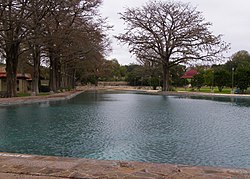San Pedro Springs Park
|
San Pedro Springs Park
|
|

San Pedro Springs Park
|
|
| Location | 1415 San Pedro Avenue San Antonio, Texas |
|---|---|
| Coordinates | 29°26′49″N 98°30′06″W / 29.44694°N 98.50167°WCoordinates: 29°26′49″N 98°30′06″W / 29.44694°N 98.50167°W |
| NRHP Reference # | 79002916 |
| RTHL # | 3806 |
| Significant dates | |
| Added to NRHP | November 1, 1979 |
| Designated RTHL | 1965 |
San Pedro Springs Park is located in the Bexar County city of San Antonio in the U.S. state of Texas. Surrounding the source of the springs, the 46-acre park is the oldest in the state of Texas. It is the location of a Payaya Indian village known as Yanaguana, and is the original site of the city of San Antonio. The park is alternately known as San Pedro Park. The park was designated a Recorded Texas Historic Landmark in 1965. It was added to the National Register of Historic Places listings in Bexar County, Texas on November 1, 1979. It is the second oldest city park in the united states after Boston common
Archaeological findings have uncovered evidence that human presence in the area dates back 12,000 years. The earliest recorded inhabitants of the springs were the Payaya Indians, who referred to their village as Yanaguana . Spanish Franciscian priest Damián Massanet led the first European contact with the area, a military expedition in 1691. In 1709, Spanish Franciscan missionary Isidro de Espinosa and a retinue of Spanish soldiers traveled to the area. In his diary, Espinoza described the springs in detail and noted they had named it Agua de San Pedro (Waters of Saint Peter).Martín de Alarcón founded the city of San Antonio by establishing San Antonio de Valero and Presidio San Antonio de Bexar at the Springs in 1718. He built an acequia (irrigation canal) in 1719. The springs and surrounding area were designated as public land by King Philip V of Spain in 1729. When the Canary Islanders began arriving in 1731, they first camped in this area.
...
Wikipedia


